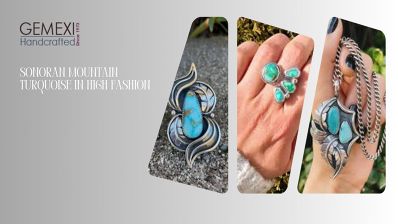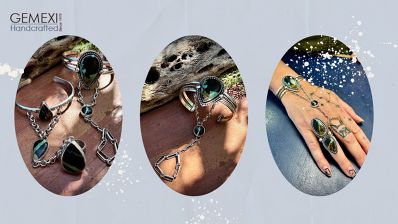Exploring the Diverse Styles of Native American Jewelry: Patterns, Designs, and Stones
By Gemexi Team | Turquoise- Updated On Jul 5, 2023

Introduction: Native American jewelry is renowned for its intricate craftsmanship, rich cultural symbolism, and timeless beauty. The artistry and attention to detail displayed in each piece reflect the deep connection between Native American tribes and their heritage. In this comprehensive guide, we will delve into 12 distinct styles of Native American jewelry, exploring their unique patterns, designs, and the stones commonly used in their creation. Join us on this journey as we celebrate the exquisite artistry and cultural significance of Native American jewelry.
- I. Squash Blossom Necklace: The Squash Blossom necklace is an iconic piece in Native American jewelry. It features a central pendant resembling a squash blossom, surrounded by silver beads and turquoise stones. The intricate silverwork, typically showcasing floral and leaf motifs, complements the vibrant turquoise stones, symbolizing protection and prosperity.
- II. Navajo Cluster: Navajo Cluster jewelry is characterized by an abundance of gemstones meticulously arranged in intricate patterns. The stones, often turquoise, coral, or other vibrant gems, are set in clusters on silver settings. The elaborate designs create a stunning visual display and showcase the skillful craftsmanship of Navajo artisans.
- III. Hopi Overlay: Hopi Overlay jewelry is renowned for its intricate silverwork and symbolic designs. The technique involves layering two sheets of silver, with the top sheet intricately cut to reveal intricate patterns and symbols. These designs often depict traditional Hopi symbols such as kachina figures or geometric patterns, representing elements of Hopi mythology and spirituality.
- IV. Zuni Inlay: Zuni Inlay jewelry is characterized by the use of small, precisely cut stones arranged in mosaic-like patterns. The stones, including turquoise, coral, shell, and jet, are intricately set into silver channels, creating geometric and intricate designs. Zuni artisans have mastered the art of stone inlay, resulting in breathtaking pieces that showcase their exceptional craftsmanship.
- V. Santo Domingo Heishi: Santo Domingo Heishijewelry is known for its distinctive use of small, disc-shaped beads made from various materials such as turquoise, shell, and coral. The beads are meticulously hand-cut and polished, then strung together to create vibrant necklaces and bracelets. Santo Domingo artists have perfected the art of creating intricate and color fulheishi jewelry.
- VI. Apache Basketry: Apache Basketry jewelry draws inspiration from the traditional baskets created by the Apache people. The jewelry features silverwork that mimics the intricate patterns found in Apache baskets, showcasing their unique weaving techniques. The designs often incorporate natural elements such as feathers, shells, and turquoise stones, reflecting the Apache's deep connection to the natural world.
- VII. Pueblo Revival: Pueblo Revival jewelry emerged during the early 20th century and draws inspiration from the architecture and pottery of Pueblo tribes. The jewelry often features heavy silverwork, incorporating geometric designs and traditional motifs. Turquoise and other colorful stones are used to accentuate the silverwork, creating bold and distinctive pieces.
- VIII. Lakota Sioux Quillwork: Lakota Sioux Quillwork jewelry reflects the traditional art of quillwork, which involves using dyed porcupine quills to create intricate patterns and designs. In jewelry, quills are often combined with beads and silverwork to create vibrant and textured pieces that celebrate the artistry and cultural heritage of the Lakota Sioux people.
- IX. Choctaw Silverwork: Choctaw Silverwork is characterized by its distinctive silver filigree and delicate designs. The jewelry often features intricate silver patterns, such as scrolls, vines, and floral motifs, reminiscent of European filigree work. The combination of silverwork and colorful gemstones creates elegant and eye-catching pieces.
- X. Iroquois Raised Beadwork: Iroquois Raised Beadwork jewelry showcases the traditional art of beadwork, where tiny beads are stitched together to create intricate patterns and designs. The jewelry often features floral motifs, animals, or cultural symbols, with vibrant bead colors representing traditional Iroquois colors and spirituality.
- XI. Cherokee River Cane: Cherokee River Cane jewelry pays homage to the traditional Cherokee craft of river cane basketry. The jewelry incorporates river cane, silver, and colorful beads to create unique and wearable art. The designs often feature natural elements such as leaves and feathers, symbolizing the deep connection between the Cherokee people and nature.
- XII. Mohawk Wampum: Mohawk Wampum jewelry showcases the art of wampum, which involves using purple and white shell beads to create intricate patterns and designs. The jewelry often features traditional Mohawk symbols, such as the Tree of Peace or the Thunderbird. Wampum jewelry holds cultural and historical significance, as wampum was traditionally used by Native American tribes as a form of currency and for ceremonial purposes.

Native American jewelry is renowned for its exquisite craftsmanship, cultural significance, and use of natural gemstones. The stones used in Native American jewelry play a vital role in enhancing the beauty and symbolism of each piece. These stones are carefully selected for their unique colors, patterns, and meanings. Let's explore some of the most commonly used stones in Native American jewelry and their significance.
- Turquoise: Turquoise is perhaps the most iconic and cherished stone in Native American jewelry. It is believed to bring protection, healing, and good fortune. Turquoise is often associated with the Navajo and Zuni tribes and is prominently featured in squash blossom necklaces, rings, bracelets, and earrings.
- Coral: Coral is another popular stone used in Native American jewelry. It represents life force, vitality, and protection against evil spirits. Red and pink corals are commonly used in necklaces, earrings, and rings, adding a vibrant touch to the pieces.
- Onyx: Onyx is a powerful stone symbolizing strength and protection. It is often used in intricate silverwork, creating striking contrast and adding depth to the jewelry. Onyx is frequently found in bracelets, necklaces, and rings.
- Lapis Lazuli: Lapis Lazuli is a deep blue stone associated with spiritual enlightenment, wisdom, and truth. It is commonly used in inlay work and beadwork, adding a touch of vibrant blue to the jewelry pieces.
- Mother of Pearl: Mother of Pearl is known for its iridescent beauty and is often used to create intricate inlay designs. It symbolizes intuition, purity, and protection. Mother of Pearl is frequently seen in earrings, pendants, and rings.
- Coraline: Coraline, or white shell, is a sacred stone for many Native American tribes. It is used to create intricate inlay work, depicting intricate patterns and symbolic designs. Coraline is often seen in Zuni jewelry, particularly in the famous Zuni cluster style.
- Jet: Jet is a black stone that has been used in Native American jewelry for centuries. It is associated with protection, purification, and grounding energy. Jet is commonly used in necklaces, earrings, and bracelets, providing a bold and elegant look.
- Amethyst: Amethyst is a purple stone symbolizing spirituality, calmness, and intuition. It is used in a variety of Native American jewelry pieces, including rings, pendants, and earrings. The deep purple hues of amethyst add a touch of regal beauty to the designs.
- Spiny Oyster Shell: Spiny Oyster Shell is valued for its vibrant orange and red colors, symbolizing vitality, passion, and creativity. It is often used in earrings, pendants, and bracelets, adding a pop of warm and energetic tones to the jewelry.
- Gaspeite: Gaspeite is a rare green stone found in only a few locations around the world. It is treasured for its unique color and is used in Native American jewelry to represent growth, healing, and spiritual transformation. Gaspeite is often seen in earrings, rings, and pendants.
These are just a few examples of the stones commonly used in Native American jewelry. Each stone carries its own unique energy and symbolism, enhancing the beauty and cultural significance of the pieces. Whether it's turquoise, coral, onyx, or any other stone, Native American jewelry showcases the deep connection between the Indigenous people and the natural world, honoring traditions and carrying forward their rich heritage.
Conclusion: Native American jewelry encompasses a rich tapestry of styles, each with its own distinct patterns, designs, and stones. From the iconic Squash Blossom necklace to the intricate Zuni Inlay and the symbolic Hopi Overlay, these jewelry styles not only showcase exceptional craftsmanship but also carry deep cultural and spiritual significance. By understanding the unique characteristics of each style, we can appreciate the beauty and artistry of Native American jewelry and honor the rich traditions of the Indigenous people who create these remarkable pieces.
Conclusion: Native American jewelry encompasses a rich tapestry of styles, each with its own distinct patterns, designs, and stones. From the iconic Squash Blossom necklace to the intricate Zuni Inlay and the symbolic Hopi Overlay, these jewelry styles not only showcase exceptional craftsmanship but also carry deep cultural and spiritual significance. By understanding the unique characteristics of each style, we can appreciate the beauty and artistry of Native American jewelry and honor the rich traditions of the Indigenous people who create these remarkable pieces.
- Tags:
- Amethyst
- Turquoise
- Squash Blossom Necklace
- Hopi Overlay
- Zuni Inlay
- Navajo Cluster
- Coral
- Coraline
- Mother Of Pearl
- Onyx
- Lapis Lazuli
- Spiny Oyster










0 Comments
Write Comments